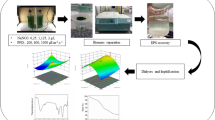Abstract
The kinetic study of Arthrospira platensis extracellular polymeric substances (EPS) production under different trophic modes—photoautotrophy (100 μmol photons m−2 s−1), heterotrophy (1.5 g/L glucose), and mixotrophy (100 μmol photons m−2 s−1 and 1.5 g/L glucose)—was investigated. Under photoautotrophic and heterotrophic conditions, the maximum EPS production 219.61 ± 4.73 and 30.30 ± 1.97 mg/L, respectively, occurred during the stationary phase. Under a mixotrophic condition, the maximum EPS production (290.50 ± 2.21 mg/L) was observed during the early stationary phase. The highest specific EPS productivity (433.62 mg/g per day) was obtained under a photoautotrophic culture. The lowest specific EPS productivity (38.33 mg/g per day) was observed for the heterotrophic culture. The effects of glucose concentration, light intensity, and their interaction in mixotrophic culture on A. platensis EPS production were evaluated by means of 32 factorial design and response surface methodology. This design was carried out with a glucose concentration of 0.5, 1.5, and 2.5 g/L and at light levels of 50, 100, and 150 μmol photons m−2 s−1. Statistical analysis of the model demonstrated that EPS concentration and EPS yield were mainly influenced by glucose concentration and that conditions optimizing EPS concentration were dissimilar from those optimizing EPS yield. The highest maximum predicted EPS concentration (369.3 mg/L) was found at 150 μmol photons m−2 s−1 light intensity and 2.4 g/L glucose concentration, while the highest maximum predicted EPS yield (364.3 mg/g) was recorded at 115 μmol photons m−2 s−1 light intensity and 1.8 g/L glucose concentration.



Similar content being viewed by others
References
Andrade MR, Costa JAV (2007) Mixotrophic cultivation of microalga Spirulina platensis using molasses as organic substrate. Aquaculture 264:130–134
Ben Dhiab R, Ben Ouada H, Boussetta H, Franck F, Elabed A, Brouers M (2007) Growth, fluorescence, photosynthetic O2 production and pigment content of salt adapted cultures of Arthrospira (Spirulina) platensis. J Appl Phycol 19:293–301
Ben Dhiab R, Ghenim N, Trabelsi L, Yahia A, Challouf R, Ghozzi K, Ammar J, Omrane H, Ben Ouada H (2010) Modeling growth and photosynthetic response in Arthrospira platensis as function of light intensity and glucose concentration using factorial design. J Appl Phycol 22:745–752
Chen F, Zhang Y, Guo S (1996) Growth and phycocyanin formation of Spirulina platensis in photoheterotrophic culture. Biotechnol Lett 18:603–608
Chen TF, Zheng WJ, Fang Y, Bai Y, Wang YS (2006) Mixotrophic culture of high selenium-enriched Spirulina platensis on acetate and the enhanced production of photosynthetic pigments. Enzyme Microb Technol 39:103–107
Costa JAV, Colla LM, Duarte Filho PF, Kabke K, Weber A (2002) Modelling of Spirulina platensis growth in fresh water using response surface methodology. World J Microbiol Biotechnol 18:603–607
De Philippis R, Vincenzini M (1998) Exocellular polysaccharide from cyanobacteria and their possible applications. FEMS Microbiol Rev 22:151–175
Guillaume Cogne JB, Gros Dussap CG (2003) Identification of a metabolic network structure representative of Arthrospira (spirulina) platensis metabolism. Biotechnol Bioeng 84:667–676
Hata J, Hua Q, Yang C, Taya KM (2000) Characterization of energy conversion based on metabolic flux analysis in mixotrophic liverwort cells Marchantia polymorpha. Biochem Eng J 6:65–74
Jia S, Yu H, Lin Y, Dai Y (2007) Characterization of extracellular polysaccharides from Nostoc flagelliforme cells in liquid suspension culture. Biotechnol Bioprocess Eng 12:271–275
Majdoub H, Ben Mansour M, Chaubet F, Roudesli S, Maaroufi RM (2009) Anticoagulant activity of a sulfated polysaccharide from the green alga Arthrospira platensis. Biochim Biophys Acta 1790:1377–1381
Marquez FJ, Sasaki K, Kakizono T, Nishio N, Nagai S (1993) Growth characteristics of Spirulina platensis in mixotrophic and heterotrophic conditions. J Ferment Bioeng 76:408–410
Miller GL (1959) Use of dinitrosalicylic acid reagent for determination of reducing sugar. Anal Chem 31:426–428
Narang A, Pilyugin SS (2005) Towards an integrated physiological theory of microbial growth: from subcellular variables to population dynamics. Math Biosci Eng 2:173–210
Pereira S, Zille A, Micheletti E, Moradas-ferreira P, De Philippis R, Tamagnini P (2009) Complexity of cyanobacterial exopolysaccharides: composition, structures, inducing factors and putative genes involved in their biosynthesis and assembly. FEMS Microbiol Rev 33:917–941
Trabelsi L, Ben Ouada H, Bacha H, Ghoul M (2009a) Combined effect of temperature and light intensity on growth and extracellular polymeric substances production by the cyanobacterium Arthrospira platensis. J Appl Phycol 21:405–412
Trabelsi L, M’sakni NH, Ben Ouada H, Bacha H, Roudesli S (2009b) Partial characterization of extracellular polysaccharides produced by cyanobacterium Arthrospira platensis. Biotechnol Bioprocess Eng 14:27–31
Vonshak A, Cheung SM, Chen F (2000) Mixotrophic growth modifies the response of Sprulina (Arthrospira) platensis (cyanobacteria) cells to light. J Phycol 36:675–679
Yim HJ, Kim SJ, Ahn SH, Lee HK (2003) Optimal conditions for the production of sulphated polysaccharide by marine microalga Gyrodinium impudicum strain KG 03. Biomol Eng 20:273–280
Zarrouk C (1966) Contribution à l’étude d’une cyanophycée. Influence de divers facteurs physiques et chimiques sur la croissance et la photosynthèse de Spirulina maxima. Ph.D. Thesis, University of Paris, Paris, France
Author information
Authors and Affiliations
Corresponding author
Rights and permissions
About this article
Cite this article
Trabelsi, L., Ben Ouada, H., Zili, F. et al. Evaluation of Arthrospira platensis extracellular polymeric substances production in photoautotrophic, heterotrophic and mixotrophic conditions. Folia Microbiol 58, 39–45 (2013). https://doi.org/10.1007/s12223-012-0170-1
Received:
Accepted:
Published:
Issue Date:
DOI: https://doi.org/10.1007/s12223-012-0170-1




